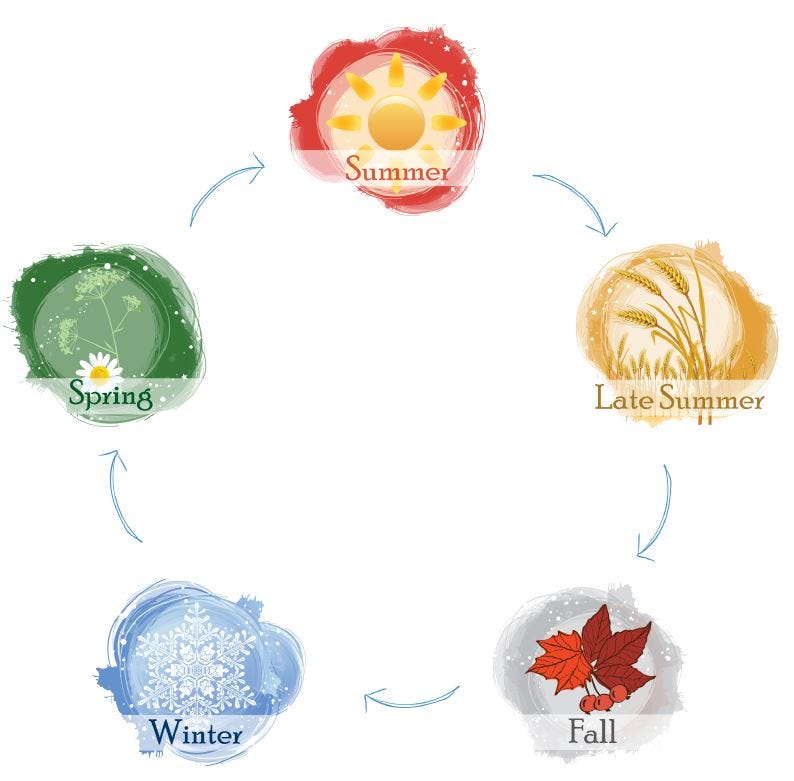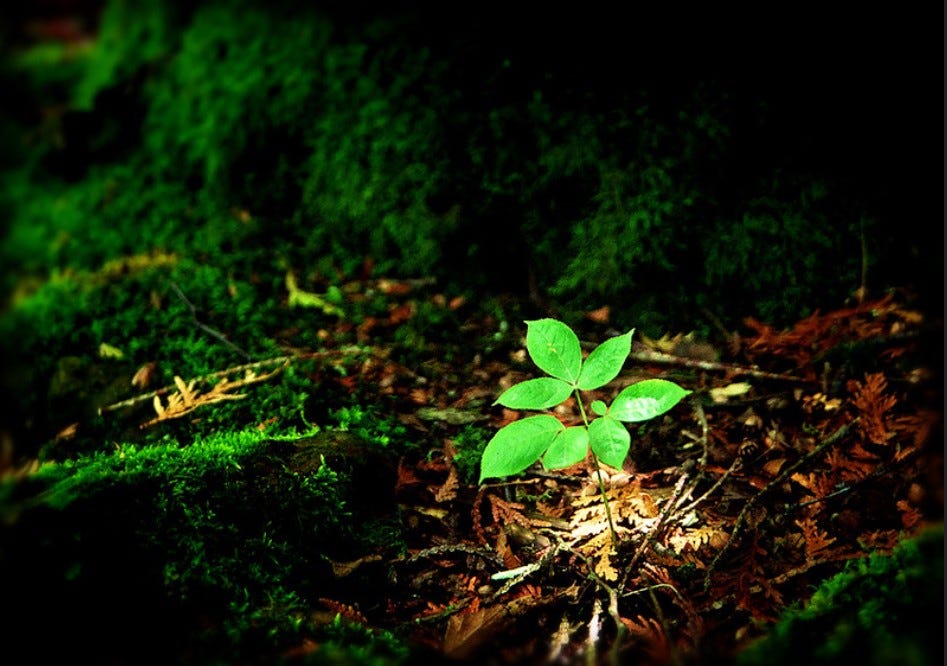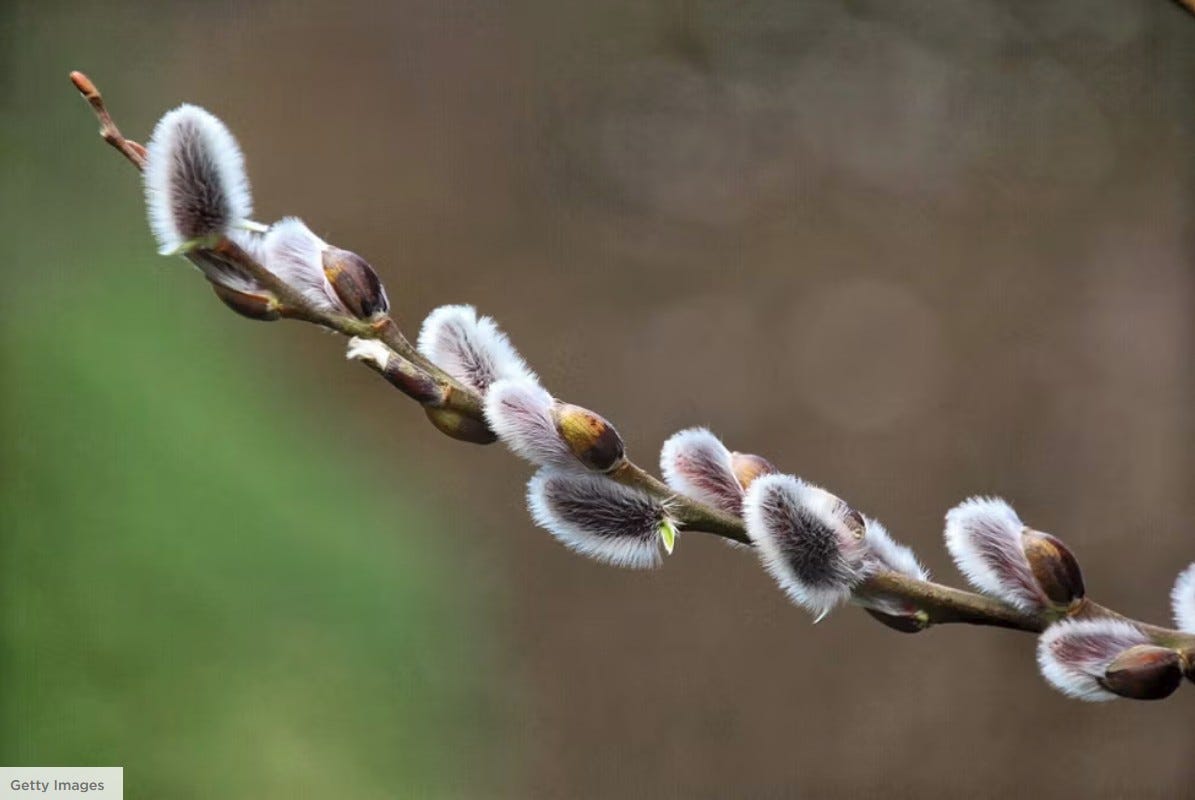Welcome to the third post on The Five Phases. The first two paragraphs below repeat the introduction to this Traditional Chinese Medicine (TCM) concept. You can find other posts in this mini-series here.
The Cosmic Dance of the Seasons
For many cultures, the changing seasons signal when it's time to alter both external and internal activities. Our ancestors believed that aligning with what was happening "in nature" helped them to live harmoniously and in right relationship with the world around them. Indeed, they didn't see themselves apart from nature at all. Following Mother Earth's cues, as a part of nature, helped them survive.
Traditional Chinese Medicine (TCM) divides the year into Five Phases. Also known as Wu Xing or the Cosmic Dance of the Seasons, it is a way of explaining both the inner and outer worlds that we inhabit. Although the People's Republic of China is relatively new, TCM has been used for over 5,000 years in that region to understand, diagnose, and heal. TCM is an intricate and highly effective system created by observing nature's cycles and interpreting and applying them to people.
Ah, Spring! There is a reason why we call it “spring fever.” After hunkering down during the cold and dreary winter months, we are ready for a change. Whether we emerge sleepily like the hibernators or burst forth like new shoots, spring fever hits when the sun grows brighter and our clothes get lighter.

Each season, or phase, corresponds to a specific element. Spring is associated with Wood. In the Spring, Wood awakens and expands. It symbolizes creation and growth. As its roots plunge down into the soil and its branches reach up into the sky, Wood symbolizes a link between Earth and Heaven, creatively turning heavenly energy into earthly form. Spring is a time for new beginnings and rebirth.
Themes of Spring (Wood)
The TCM themes associated with Spring or Wood are activity and movement. Spring is also about hope and determination. It’s where you begin to act on the vision and dreams from the restorative time of Winter. In Nature, the seed that was full of potential is now bursting forth in the Spring into the light. For people, it means the primary focus is on getting out in the world and getting things done.
Each phase is also associated with organs in the body. TCM relates Spring/Wood to the Liver and Gallbladder.1 In TCM, the Liver maintains the smooth flow of Qi (your energetic life force) and Blood. Physically, it is responsible for moving the Blood upward and outward, ensuring that the farther-away head and limbs are nourished. The Gallbladder stores and secretes bile, which aids in assimilation and elimination. Figuratively, the Liver imparts the power of action and the Gallbladder the power of decision through clarity of vision, thought, and decision making.
The Liver and Gallbladder are also associated with anger, manifesting as irritability, frustration or impatience (how galling!). On a societal level, nearly everyone in America recognizes and in some way identifies with the Spring/Wood personality. We live in a very “Spring-heavy” culture with our impatient, achievement-oriented, “silly, knees-bent, running about advancing behavior.” (Name that movie!)
Gail Reichstein, author of Wood Becomes Water, writes:
“On an emotional level, the Wood element expresses itself as vision and direction, channeling energies toward a particular focus. Like the trunk of a tree or the funnel of a tornado, Wood directs resources into a desired form. Whether what you want is a day to relax, a career as a lawyer, or a living room with a certain “feel” to it, directed Wood energy envisions a goal and propels the seed of vision forward into action. Positively expressed, Wood energy manifests as the courage of conviction, appropriate action, and the ability to hold one’s ground.
Wood’s strength is tested whenever our internal sense of direction is challenged, whether by argument, doubt, or circumstance. If we abandon our plans too easily, Wood lacks power within us, while if we cleave too stubbornly to mistaken or unwise plans, Wood is overly rigid. Ideally, however, Wood manages the tension between firmness and flexibility, allowing our rootedness to create a stable base from which we can bend."
The Gifts of Spring (Wood)
When we are fully embodying or honoring the season of Spring, we are emerging from our own hibernation. We are moving out of the rest and dream time of Winter, and we are beginning to take action on those dreams. We are “building with balance”, giving ourselves enough structure to bring our dreams into the world, but not so much that we become too rigid and incapable of making needed changes.
The gifts of Spring or Wood include:
Developing your Vision (purpose).
Making decisions and action plans (manifesting the Vision).
Organizing and planning.
Making good choices for ourselves.
Standing by our choices, but being flexible when things don’t go as expected.
Using flexible structure to eventually express our gifts in the world.
How do you know if you are living in harmony with the Wood phase? You have:
A full, smooth expression of will through a well-crafted vision.
Effective, flexible and creative approaches to problems.
Appropriate boundaries.
Assertiveness and decisiveness together with flexibility.
A sense of hopefulness despite challenges.
“Living in harmony” requires continual adjustments: some days are better than others. The following are clues for when you might need to bring yourself back into balance in this Spring phase. You can usually tell how you’re out of balance by the quality of your energy. For example, are you finding it hard to make decisions? Or busy running around on auto-pilot? You might want to lean into more of Spring’s gifts. Perhaps you are heavy on the “overs”: over-confident, over-achieving, overly structured? It may be time to swap out rigidness for flexibility.
How can you tell if you are under expressing Spring (Wood deficient)? You may:
Be indecisive.
Have poor boundaries (with your time and energy).
Have no structure to your life or daily/weekly activities.
Feel overwhelmed.
Be very busy and stressed, but don’t have the overall vision for what you’re doing. (“Energy without a plan” may result in anxiety, ADD, hyperactivity or poor digestion.)
How can you tell if you are over expressing Spring (Wood excess)? You may:
Be overly structured and rigid, inflexible.
Be hyper-focused, exhibiting “Type A” characteristics.
Be impatient; easily frustrated with self and others.
Be over-confident, over-achieving and on “hyperdrive”.
Lack self-reflection.
Be quick to anger or have explosive anger.
Experience ulcers, tense muscles (especially neck and shoulders), tension headaches, or jaw pain.
Practical tips for living in harmony with the Spring season
If you find yourself feeling out of balance during this season, you might want to try one or more of these helpful practices:
Vision boarding/mind mapping.
Making to-do lists (if you don’t normally do that).
Gentle movement: stretching, yoga, swimming.
Walking meditation.
Good eye contact and clear, direct speech.
Eat small amounts of sour foods like lemons, yogurt, limes, pickles, sauerkraut, vinegar, apples, and olives. (Sour foods stimulate the Liver and Gallbladder. Drinking warm lemon water in the morning is a personal favorite.)
Incorporate more cooked greens/green vegetables and berries (e.g., strawberries, raspberries, cranberries, blueberries) into your diet if you’re feeling the need to chill the heck out. (Greens work for both Wood deficiency and excess, so they’re good any time!)
Are you ready to thrive in Spring? Can you look toward your future with hope and excitement? Are you able to stay firm, yet flexible, in your plans for achieving your vision or goals? Are you able to maintain integrity in the face of change? Balancing firmness and flexibility is inherent in many aspects of our lives this season.
Sources:
Beinfield, Harriet and Korngold, Efrem. Between Heaven and Earth: A Guide to Chinese Medicine, New York: Ballantine Books, 1991. Print.
Reichstein, Gail. Wood Becomes Water: Chinese Medicine in Everyday Life, New York: Kodansha USA, Inc, 1998. Print.
Larken Bunce. Five Phases: The Nature of Your Health. Nov. 2015. Webinar.
Originally written 2018; edited April 2025.
TCM words and references are capitalized and italicized to distinguish their concept/meanings, e.g., Liver.







